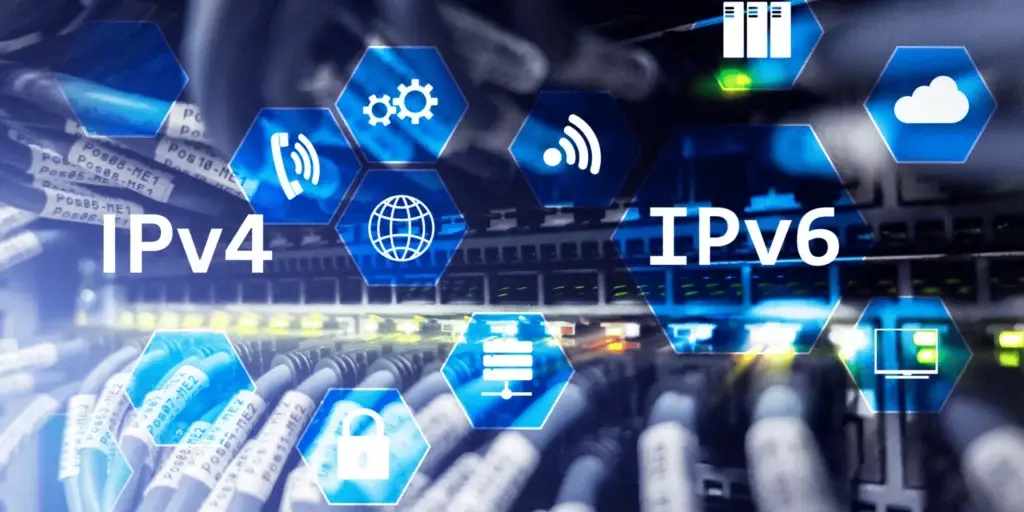The internet has become an integral part of our lives, and IP addressing is the backbone that makes it all possible. However, with the increasing number of devices connected to the internet, there is a need for more IP addresses. This is where IPv6 comes into play.
This blog post will discuss everything you need to know about IPv4 vs IPv6. We will cover the key differences between the two protocols, the advantages of IPv6 over IPv4, the challenges in adopting IPv6, and strategies for transitioning from IPv4 to IPv6.
We will also look at the future of IP addressing and how IPBurger’s proxies can help ensure online privacy and security.
So, buckle up, and let’s dive deep into internet protocol!
What is Ip4 and what is Ip6?
IPv4 (Internet Protocol version 4) and IPv6 (Internet Protocol version 6) are two different versions of the Internet Protocol, which is the protocol that governs the way data is sent and received over the Internet.
IPv4 is the original version of the Internet Protocol, while IPv6 is the newer version developed to address the limitations of IPv4. One major limitation of IPv4 is its finite address space, with only 32-bit decimal numbers available for use.
In contrast, IPv6 addresses are 128-bit, offering large blocks and virtually unlimited unique addresses. This increased number of available addresses in IPv6 allows for more devices to be connected to the internet as we move towards a more connected future with an increasing number of devices.
Most modern devices support both IPv4 and IPv6, but some older hardware may only support one or the other. As such, adopting IPv6 is becoming increasingly important for ensuring continued connectivity.
Vocabulary
TCP: TCP (Transmission Control Protocol) is a commonly used protocol for transmitting data over the Internet. It ensures reliability and error-free delivery of data packets between devices by establishing connection-oriented communication between them. TCP is often used in conjunction with IP protocols, including IPv4 and IPv6.
ISP: ISP stands for Internet Service Provider, which is a company that provides Internet access to customers. ISPs provide various plans and packages for internet connectivity, such as broadband, DSL, cable, and wireless services.
End-user: An end-user is a person or entity that uses a product or service. In the context of the internet, an internet user, or end-user, refers to individuals who access and use online services or applications.
Subnet mask: A subnet mask is a number used to divide an IP network into smaller subnetworks. It establishes a boundary for the network by indicating which part of the IP address represents the network and which part represents the host.
Destination address: The destination address refers to the device’s IP address or location where data packets are being sent. In the context of IPv4 and IPv6, the destination address is used to direct network traffic from one device to another over the internet.
Link-local addresses: Link-local addresses are IP addresses that are used for communication within a single subnet. They are typically only used for local network communication and cannot be used to communicate with devices outside the local network.
Classless inter-domain routing: (CIDR) is an IP address allocation method to optimize internet address space. CIDR allows for more efficient allocation and routing of IP addresses by dividing networks into smaller subnets with variable-length subnet masks.
Host identifier: A host identifier is a unique identifier assigned to a device within a network. It is used to distinguish one device from another sender on the same network. In the context of IPv4 and IPv6, the host identifier is the part of the IP address representing the specific network device.
CIDR notation: CIDR (Classless Inter-Domain Routing) is a method of IP address allocation that has revolutionized how we use the public internet. It allows for more efficient use of internet address space by breaking down networks into smaller subnets with variable-length subnet masks.
Octet: In IPv4, an octet is a group of 8 bits representing a section of the IP address. Four dot-separated octets, ranging from 0 to 255, comprise the IPv4 address. For example, the IP address 192.168.0.1 has four octets: 192, 168, 0, and 1.
SSL: SSL (Secure Sockets Layer) is a security protocol to establish an encryption link between a web server and a user’s web browser.
Regional Internet Registries
But before we delve into the differences between IPv4 and IPv6, it’s important to understand the role of Regional Internet Registries (RIRs) in internet protocol address allocation. RIRs are responsible for assigning and managing IP addresses within their respective regions.
There are five RIRs across the globe, each serving a different region: AFRINIC in Africa, APNIC in Asia Pacific, ARIN in North America, LACNIC in Latin America and the Caribbean, and RIPE NCC in Europe, the Middle East, and Central Asia. These organizations work together to ensure that the allocation of IP addresses is done efficiently and fairly.
Internet Engineering Task Force
Another important organization for developing and maintaining IP protocols is the Internet Engineering Task Force (IETF). This global community of volunteers plays a crucial role in creating new standards for internet protocols and ensuring interoperability between different systems. It was through the work of the IETF that IPv6 was developed and standardized, paving the way for improved connectivity and addressing the limitations of the older IPv4 protocol.
As technology continues to evolve, it will be up to organizations like the RIRs and IETF to ensure that our networks can keep up with the demands of a connected world.
Dynamic Host Configuration Protocol
One of the key differences between IPv4 and IPv6 is the way in which IP addresses are assigned to network devices. With IPv4, IP addresses were often statically assigned or manually configured, which could be time-consuming and inefficient. The Dynamic Host Configuration Protocol (DHCP) was developed as a way to automate this process, allowing devices to automatically obtain an IP address from a DHCP server on the network.
Stateless Address Autoconfiguration (SLAAC), a feature of IPv6, goes one step further by enabling devices to create their own distinctive IP addresses using the network prefix that the router has advertised. This means that even without a DHCP server, devices can still obtain an IP address and connect to the network. This makes the process of assigning IP addresses simpler and more efficient, reducing the administrative burden on network administrators.
Additionally, IPv6 offers a much larger address space than the IPv4 32-bit address, which means more unique IP addresses are available for devices. This is particularly important in a world where more and more devices are being connected to the internet, as it ensures that we don’t run out of available IP addresses anytime soon.
IANA
The Internet Assigned Numbers Authority (IANA) is responsible for managing the global pool of IP addresses, both IPv4 and IPv6. As the demand for IP addresses continues to grow, IANA has allocated blocks of IPv6 addresses to the Regional Internet Registries (RIRs), who distribute them to internet service providers and organizations.

Key Differences Between IPv4 and IPv6
When comparing IPv4 and IPv6, the most significant difference lies in their address spaces.
IPv4 is the first version and uses 32-bit addresses, allowing for approximately 4.3 billion unique IP addresses. In contrast, the second internet protocol version, IPv6, uses 128-bit addresses, providing a much larger pool of unique IP addresses than IPv4. This increased address space is essential as the number of connected devices continues to grow exponentially.
Another key difference between the two protocols is how they handle automatic private IP addressing.
IPv4 uses broadcast addressing to send packets to multiple devices on a network, while IPv6 uses multicast addressing. Additionally, IPv6 supports larger packet sizes and is designed for higher performance and security. However, despite these advantages, compatibility with existing technology remains challenging for the widespread adoption of IPv6.
Which is better Ip4 or Ip6?
IPv4 has been widely used for decades and is still in use today, but it has limitations regarding address space and security. IPv6 was developed to address these limitations and provides a much larger pool of available addresses, improved security features, and streamlined packet routing.
However, the adoption of IPv6 has been slower than anticipated due to compatibility issues with legacy systems and devices.
Larger Address Space
The most significant difference between IP4 and IP6 is the address space they provide. IPv6 has a much larger address space than IPv4, allowing an almost infinite number of devices to be connected to the internet.
With IPv6, network address translation (NAT) becomes unnecessary, which can simplify network management and improve performance. IP6 includes built-in security features such as IPsec, which offers better protection against cyberattacks.
As more and more devices become connected to the Internet, the larger address space will become increasingly important in facilitating the growth of the Internet of Things (IoT) and other emerging technologies.
Improved Security Features
As cybersecurity threats continue to increase, the security of our devices and networks has become a top priority.
IPv6 addresses meet this need by incorporating built-in security features that provide better protection against malicious attacks and hacking.
IPsec, or Internet Protocol Security, is integrated into this Internet protocol to encrypt data and ensure secure communication between devices. Improved authentication mechanisms also make verifying the identity of devices on a network easier.
Furthermore, the larger address space allows unique addresses to be assigned to every device, reducing the risk of IP address conflicts and making it harder for hackers to target specific devices.
More Efficient Packet Handling
In addition to its larger address space and improved security features, IPv6 also boasts more efficient packet handling. This is largely due to changes in how packets are processed and routed on the network.
With this internet protocol, routers have a simplified packet header format that reduces processing overhead and speeds up data transmission. This means internet traffic can be handled more efficiently and with less delay than IPv4. As a result, network performance can be significantly improved.
Better Support for Mobile Networks
Mobile networks have become an integral part of our daily lives, and IPv6 provides better support for such networks. With a larger pool of unique IP addresses, connecting more devices to the internet is easier.
Unlike IPv4, which limits the number of devices that can be connected due to its limited pool of IP addresses, 6 ensures seamless connectivity and uninterrupted services on mobile networks. This is crucial for the continued growth and development of mobile technology.
Businesses must adapt to this change by gradually transitioning from IPv4 to IPv6. More devices will be able to connect to the internet thanks to IPv6’s larger address space without running out of IP addresses. As the world becomes increasingly mobile-oriented, adopting IPv6 will be necessary for businesses that want their services accessible on the go.

IPv4 vs IPv6 Transition Strategies
As the depletion of IPv4 addresses becomes a pressing issue, transitioning to IPv6 is becoming an increasingly important consideration for companies and organizations.
Several strategies are available to shift from IPv4 to IPv6, including implementing dual-stack technology, utilizing tunneling methods, and employing translation mechanisms. Gradual transition, education, and awareness are crucial for successful implementation.
Each approach has advantages and disadvantages, depending on the organization’s specific needs and constraints. However, with the right strategy and preparation, transitioning to IPv6 can help future-proof your network infrastructure while avoiding potential security risks associated with outdated technologies.
Translation Mechanisms
Translation mechanisms are critical for communication between IPv4 and IPv6 networks. Network Address Translation (NAT) is a common mechanism that allows multiple devices to share a public IP address. NAT translates private IP addresses into public ones, which helps conserve IPv4 addresses.
Another popular translation mechanism is dual stack, which allows both IPv4 and IPv6 protocols to run concurrently on the same device or local network interface. This strategy provides a smooth transition from IPv4 to IPv6 without disrupting existing systems.
Tunneling is another translation mechanism that encapsulates one protocol inside another for communication between different network types.
Each of these translation mechanisms has unique characteristics, and choosing the right type is essential based on your network requirements, and compatibility with other devices is essential.
Dual Stack Implementation
As networks transition from IPv4 to IPv6, dual-stack implementation has emerged as a preferred strategy. It enables the simultaneous use of both protocols, which allows for a seamless transition from IPv4 to IPv6 without disrupting existing systems.
To ensure optimal performance and security during the transition period, it’s essential to have compatible hardware and software, proper configuration, and network management. Testing and monitoring are also crucial. With the depletion of available IPv4 addresses and increasing demand for internet-connected devices, transitioning to IPv6 is necessary.
Dual stack implementation provides an efficient way to adopt this new protocol while maintaining backward compatibility with older systems.
Tunneling Methods
Tunneling is a crucial mechanism for enabling communication between networks that have not yet fully transitioned to IPv6. It involves encapsulating IPv6 packets within IPv4 packets, allowing the data to travel across an IPv4 network.
Several tunneling methods are available, each with its own strengths and weaknesses.
- The 6to4 method is automatic and requires no additional configuration, but it may not work well in certain network environments.
- Teredo tunnels can traverse NAT devices but may be slower due to additional overhead.
- ISATAP tunnels are best suited for enterprise networks, requiring more configuration but offering better performance.
Ultimately, the tunneling method chosen will depend on your network’s specific needs and constraints.
Future of IP Addressing
The future of IP addressing is closely tied to the adoption and implementation of IPv6. With its larger address space, IPv6 offers almost limitless room for growth and innovation in the Internet of Things (IoT) era.
However, as the transition from IPv4 to IPv6 requires significant changes to network infrastructure, it may take time for businesses and individuals to fully embrace the new protocol. Despite this, many web pages and networks are gradually shifting towards IPv6, with some countries even mandating its common use in government systems.
As IPv4 and IPv6 will likely coexist for some time, it’s essential to understand their differences and stay informed about the transition process.

IPBurger’s IPv4 & IPv6 Proxies
IPBurger is a provider of both IPv4 and IPv6 proxies, catering to businesses and individuals with varying network requirements. IPv4 proxies are ideal for applications not supporting IPv6, while IPv6 proxies are essential for accessing websites and networks that only support the newer protocol.
With our high-speed connections and robust security features, IPBurger’s proxies offer reliable and efficient solutions for businesses looking to protect their online activities or individuals seeking anonymity online. As the world transitions towards IPv6, IPBurger is ready to provide web proxy server solutions that cater to the changing needs of its clients.
Conclusion
IPv4 and IPv6 are both internet protocols that facilitate communication between devices on the internet. While IPv4 is the most widely used protocol, IPv6 offers several advantages, such as a larger address space, improved security features, and more efficient packet handling.
However, there are challenges in adopting IPv6 due to legacy systems and infrastructure, training, education, and financial costs. To transition from IPv4 to IPv6, businesses can implement dual stack implementation, tunneling methods, or translation mechanisms.
At IPBurger, we provide secure and reliable proxies for businesses looking to enhance their online privacy and security. Contact us to learn more about our services.



